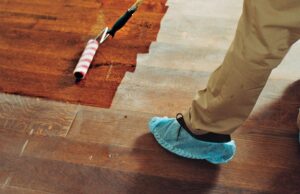Vinyl floors for kitchens (in English, vinyl floor), also called sintasol, are PVC coatings made of polyurethane and composed of 4 or 5 layers (depending on the resistance we want to choose) resistant to water (water-repellent), hygienic, non-slip and with thousands of different shapes, finishes and colours to choose the one that best suits our kitchen.
Vinyl flooring can be purchased in packages that contain several units of click system slats or self-adhesive tiles and are usually determined by the space in square meters that they cover. However, they can also be purchased by rolls (called continuous flooring).
Depending on the total space of our kitchen, we will have to buy more or less material to have enough vinyl flooring to cover everything we need.
Types of Vinyl Flooring for Kitchen
- Vinyl Flooring in Roll for Kitchen
- Click Vinyl Flooring for Kitchen
- Adhesive Vinyl Flooring in Planks and Tiles for Kitchen
PVC Floor for Kitchen: Advantages and Disadvantages
⇒ ADVANTAGES of Vinyl Flooring
As we can see below, there are so many benefits that it has practically no cons:
- The vinyl floor for the kitchen is very resistant to bumps and scratches; it is not marked when appliances or other furniture is dragged, and it is specially manufactured in this case for areas as busy as the kitchen.
- When you buy it, you must look at its hardness! These laminate tiles have a hardness suitable for families with pets.
-
Very economical price:
acquiring this type of PVC syntasol is very affordable for any family, and in addition to the benefits it offers, thanks to its price, we will prefer it over other ceramic or parquet slabs.
Easy to install since it is only necessary to place and adhere on the old slabs, facilitating its installation and saving time.
-
Designs of many types:
we can find slats or rolls of vinyl flooring for kitchens in all shapes and colours, imitating wood or stone and being able to adapt to the decoration.
-
Suitable for wet areas:
this vinyl floor is made to be used in wet areas such as kitchens and is also non-slip in many cases.
-
Easy cleaning of vinyl kitchen floors.
Being made of plastic and waterproof materials, we can clean our tiles with a mop and floor cleaners that do not contain solvents so as not to damage them.
Do you need to know more advantages of vinyl kitchen flooring?
- In addition, thanks to the manufacture of these vinyl coatings, we can prevent the accumulation of bacteria and mites, which makes our kitchens a more hygienic place.
-
Soft tread:
with vinyl flooring, we will notice a pleasant cushioning sensation thanks to its manufacturing layers that will also act as thermal insulation and keep our kitchen at a more pleasant average temperature.
-
Duration:
the useful life of these vinyl kitchen floors is usually between 5 to 20 years, depending on the maintenance conditions and the wear and tear they can withstand.
⇒ DISADVANTAGES – Vinyl Floor Problems
Delicate against heat:
these types of adhesive or click floors are affected by heat and sun. They can lose their colour if the sun shines on them continuously or even lose their fixation to the bottom to which they are attached.
Low-quality models:
keep in mind that low prices on this type of floor can mean a drop in quality. Do not trust low prices!
They show irregularities in the underlying paving:
Caution! It is essential, this advice being vital, to eliminate anomalies and changes in the level before glueing or assembling the vinyl slats to the previous paving if we do not want them to be marked over time, and the contour of the pavement underneath can be appreciated.
TIP:
Use a good levelling agent to bring all the old paving to the same height and even before glueing the new vinyl tiles.
How long does a vinyl floor last?
One of the advantages of the plastic floor for the kitchen is the long useful life it has, since these vinyl tiles usually last between 5 to 20 years and even more, logically depending on the maintenance and cleaning that we carry out.
They are adhesive or continuous floors prepared to be installed for a long time, withstand the constant footsteps in a kitchen and embellish our decoration.
How to lay PVC flooring for the kitchen?
Here we will give you some basic guidelines on how to apply our tiles or vinyl rolls; although you can find below these steps, you will access a super vinyl floor installation guide according to its type:
- Measure our kitchen to know its size in square meters and buy the necessary tiles, always calculating 10% more to be aware of the cuts that must be made. If you need continuous rolled flooring, you will need to measure more accurately.
- Clear obstacles and prepare our old floor by cleaning imperfections, using a levelling paste and even a priming liquid to improve the fixing of our new vinyl floor to the old pavement. These steps will depend on the type of vinyl kitchen floor you have chosen: roll, click or tile.
- We recommend starting by glueing the vinyl flooring from the centre of the kitchen since we must glue it so that it is not parallel but that the beginning of a tile coincides with the centre of the one that will be right next to it. For this, it is also advisable to make pencil guides on the ground. For roll floors, start from a kitchen corner and stick little by little to avoid creating air bubbles.
- Make the necessary cuts with a cutter when you reach the kitchen walls or find an obstacle such as a wall.




